Abstract
Purpose
To investigate and compare the effects of topical carbonic anhydrase inhibitors on the production and expression of nitric oxide in cultured human trabecular meshwork cells (HTMC).
Methods
Primarily cultured HTMC were exposed to 0, 10, and 100 µM dorzolamide and brinzolamide using serum-de-prived media for 3 days. Production of nitric oxide was assessed with Griess assay. Expressions of eNOS mRNA were assessed with RT-PCR.
Results
Both dorzolamide and brinzolamide increased the production of nitric oxide eNOS activity (p < 0.05). Dorzolamide had a more potent effect than brinzolamide on the production of nitric oxide and the expression of eNOS mRNA.
Conclusions
Topical carbonic anhydrase inhibitors increased the production of nitric oxide, which was accompanied by increased eNOS activity. Dorzolamide had a more potent effect than brinzolamide on the production of nitric oxide and expression of eNOS mRNA in HTMC. The increased production of nitric oxide by topical carbonic anhydrase inhibitors involves mechanisms other than carbonic anhydrase inhibition.
Go to : 
References
1. Sugrue MF. The preclinical pharmacology of dorzolamide hydro-chloride, a topical carbonic anhydrase inhibitor. J Ocul Pharmacol Ther. 1996; 12:363–76.
2. Sugrue MF. Pharmacological and ocular hypotensive properties of topical carbonic anhydrase inhibitors. Prog Retin Eye Res. 2000; 19:87–112.

3. Martens-Lobenhoffer J, Banditt P. Clinical pharmacokinetics of dorzolamide. Clin Pharmacokinet. 2002; 41:197–205.

4. Josefsson A, Sigurdsson SB, Bang K, Eysteinsson T. Dorzolamide induces vasodilatation in isolated pre-contracted bovine retinal arteries. Exp Eye Res. 2004; 78:215–21.

5. Stefa´nsson E, Jensen PK, Eysteinsson T, et al. Optic nerve oxygen tension in pigs and the effect of carbonic anhydrase inhibitors. Invest Ophthalmol Vis Sci. 1999; 40:2756–61.
6. Pedersen DB, koch Jensen P, la Cour M, et al. Carbonic anhydrase inhibition increases retinal oxygen tension and dilates retinal vessels. Graefes Arch Clin Exp Ophthalmol. 2005; 243:163–8.
7. Torring MS, Holmgaard K, Hessellund A, et al. The vasodilating effect of acetazolamide and dorzolamide involves mechanisms other than carbonic anhydrase inhibition. Invest Ophthalmol Vis Sci. 2009; 50:345–51.

8. Aamand R, Dalsgaard T, Jensen FB, et al. Generation of nitric oxide from nitrite by carbonic anhydrase: a possible link between metabolic activity and vasodilation. Am J Physiol Heart Circ Physiol. 2009; 297:H2068–74.

9. Alvarado J, Murphy C, Juster R. Trabecular meshwork cellularity in primary open-angle glaucoma and nonglaucomatous normals. Ophthalmology. 1984; 91:564–79.

10. Rohen JW, LÜtjen-Drecoll E, FlÜgel C, et al. Ultrastructure of the trabecular meshwork in untreated cases of primary open-angle glaucoma. Exp Eye Res. 1993; 56:683–92.
11. Wiederholt M, Dörschner N, Groth J. Effect of diuretics, channel modulators, and signal interceptors on contractility of the trabecular meshwork. Ophthalmologica. 1997; 211:153–60.

12. Wiederholt M, Stumpff F. The trabecular meshwork and aqueous humor reabsorption. Civan MM, editor. Current topics in membranes. The eye's aqueous Humor: from secretion to glaucoma. San Diego: Academic Press;1998. v. 45:chap. 7.
13. Wiederholt M, Sturm A, Lepple-Wienhues A. Relaxation of trabecular meshwork and ciliary muscle by release of nitric oxide. Invest Ophthalmol Vis Sci. 1994; 35:2515–20.
14. Behar-Cohen FF, Goureau O, D’Hermies F, Courtois Y. Decreased intraocular pressure induced by nitric oxide donors is correlated to nitrite production in the rabbit eye. Invest Ophthalmol Vis Sci. 1996; 37:1711–5.
15. Dismuke WM, Mbadugha CC, Ellis DZ. NO-induced regulation of human trabecular meshwork cell volume and aqueous humor out-flow facility involve the BKCa ion channel. Am J Physiol Cell Physiol. 2008; 294:C1378–86.

16. Mosmann T. Rapid colorimetric assay for cellular growth and survival: application to proliferation and cytotoxicity assays. J Immunol Methods. 1983; 65:55–63.

17. Freimoser FM, Jakob CA, Aebi M, Tuor U. The MTT assay is a fast and reliable method for colorimetric determination of fungal cell densities. Appl Environ Microbiol. 1999; 65:3727–9.
18. Green LC, Wagner DA, Glogowski J, et al. Analysis of Nitrate, Nitrite and [15N]Nitrate in biologic fluids. Analytical Biochem. 1982; 126:131–8.
19. Kringelholt S, Simonsen U, Bek T. Dorzolamide-induced relaxation of intraocular porcine ciliary arteries in vitro depends on nitric oxide and the vascular endothelium. Curr Eye Res. 2012; 37:1107–13.

20. Sugrue MF. Pharmacological and ocular hypotensive properties of topical carbonic anhydrase inhibitors. Prog Retin Eye Res. 2000; 19:87–112.

21. Loftsson T, Jansook P, Stefánsson E. Topical drug delivery to the eye: dorzolamide. Acta Ophthalmol. 2012; 90:603–8.

22. Berg JT, Ramanathan S, Gabrielli MG, Swenson ER. Carbonic anhydrase in mammalian vascular smooth muscle. J Histochem Cytochem. 2004; 52:1101–6.

23. Kobayashi M, Naito K. Pharmacological profiles of the potent carbonic anhydrase inhibitor dorzolamide hydrochloride, a topical an-tiglaucoma agent. Nihon Yakurigaku Zasshi. 2000; 115:323–8.

24. Martinez A, Gonzalez F, Capeans C, et al. Dorzolamide effect on ocular blood flow. Invest Ophthalmol Vis Sci. 1999; 40:1270–5.
25. Costagliola C, Campa C, Parmeggiani F, et al. Effect of 2% dorzolamide on retinal blood flow: a study on juvenile primary open angle glaucoma patients already receiving 0.5% timolol. Br J Clin Pharmacol. 2007; 63:376–9.
26. Fuchsjäger-Mayrl G, Wally B, Rainer G, et al. Effect of dorzolamide and timolol on ocular blood flow in patients with primary open angle glaucoma and ocular hypertension. Br J Ophthalmol. 2005; 10:1293–7.
27. Kehler AK, Holmgaard K, Hessellund A, et al. Variable involvement of the perivascular retinal tissue in carbonic anhydrase in-hibitor– induced relaxation of porcine retinal arterioles in vitro. Invest Ophthalmol Vis Sci. 2007; 48:4688–93.
Go to : 
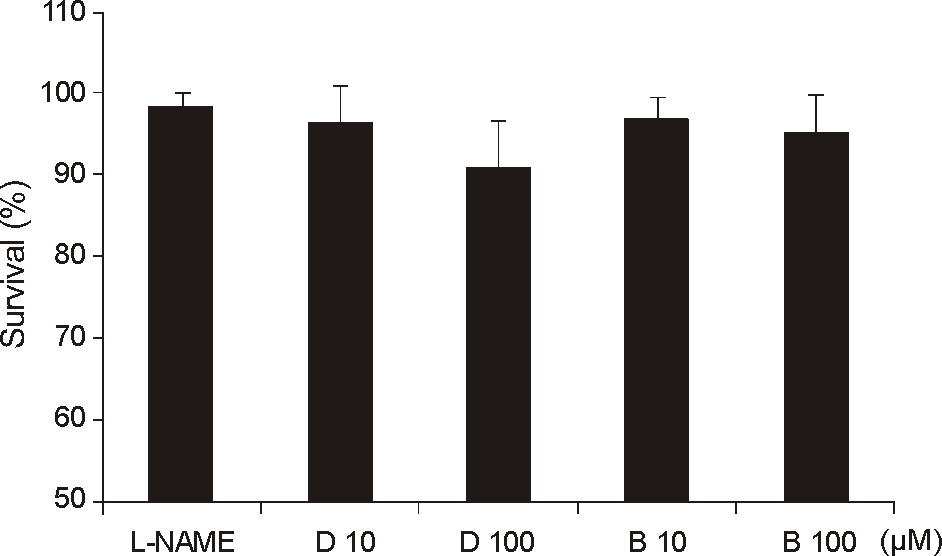 | Figure 1.Effects of topical carbonic anhydrase ihibitors on the survival of trabecular meshwork cells. Both dorzolamide (D) and brinzolamide (B) did not affect cellular survival at concentrations of 10 and 100 μ M (p > 0.05). |
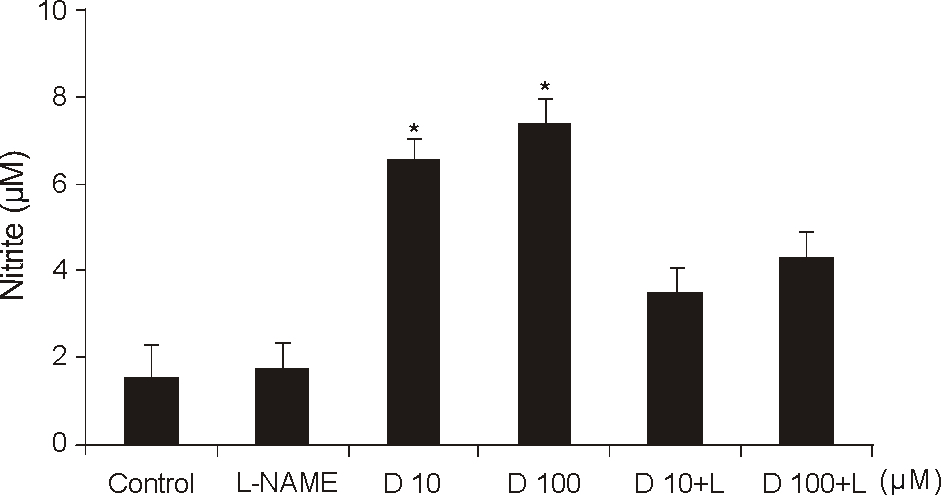 | Figure 2.Effects of topical carbonic anhydrase ihibitors on the production of nitric oxide in trabecular meshwork cells. Dorzolamide (D) increased NO production in a dose-depend-ent manner, which was abolished by co-exposed L-NAME (L) (* p < 0.05). |
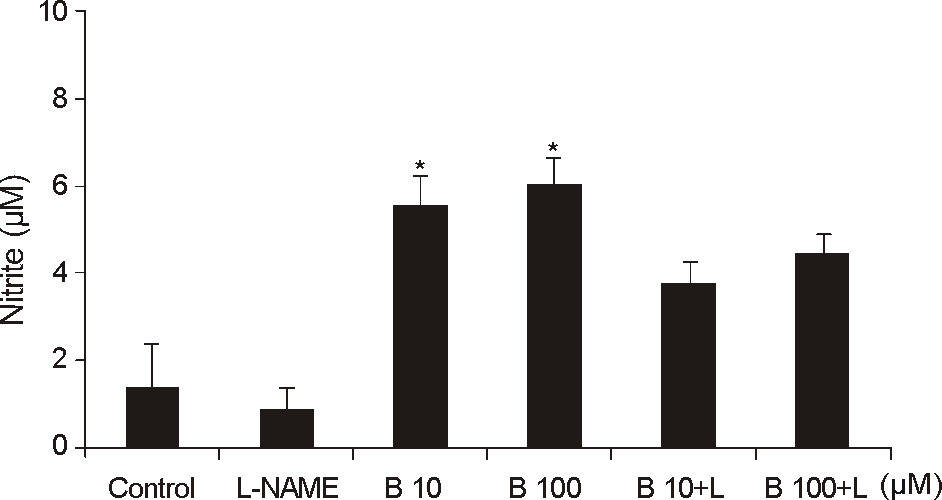 | Figure 3.Effects of topical carbonic anhydrase ihibitors on the production of nitric oxide in trabecular meshwork cells. Brinzolamide (B) increased NO production in a dose-depend-ent manner which was abolished by co-exposed L-NAME (L) (* p < 0.05). |
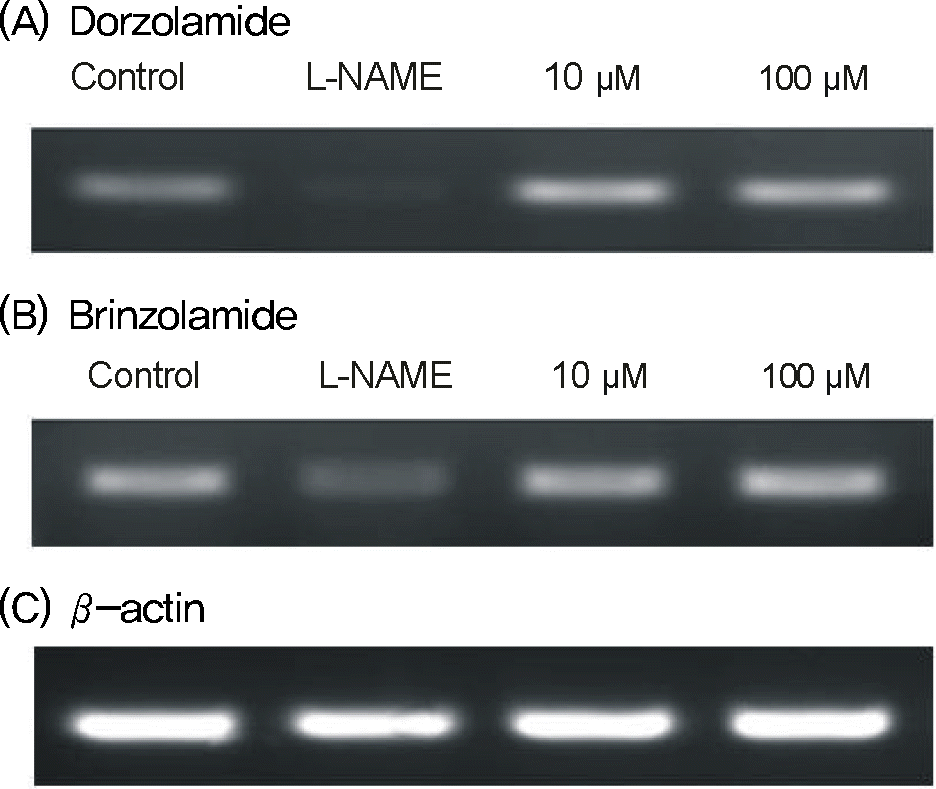 | Figure 4.Effects of topical carbonic anhydrase inhibitors on the activity of eNOS in trabecular meshwork cells. Exposure to 10, 100 μ M dorzolamide (A) or brinzolamide (B) increased eNOS mRNA expression compared to the non-exposed control.β-actin used as internal standard. |




 PDF
PDF ePub
ePub Citation
Citation Print
Print


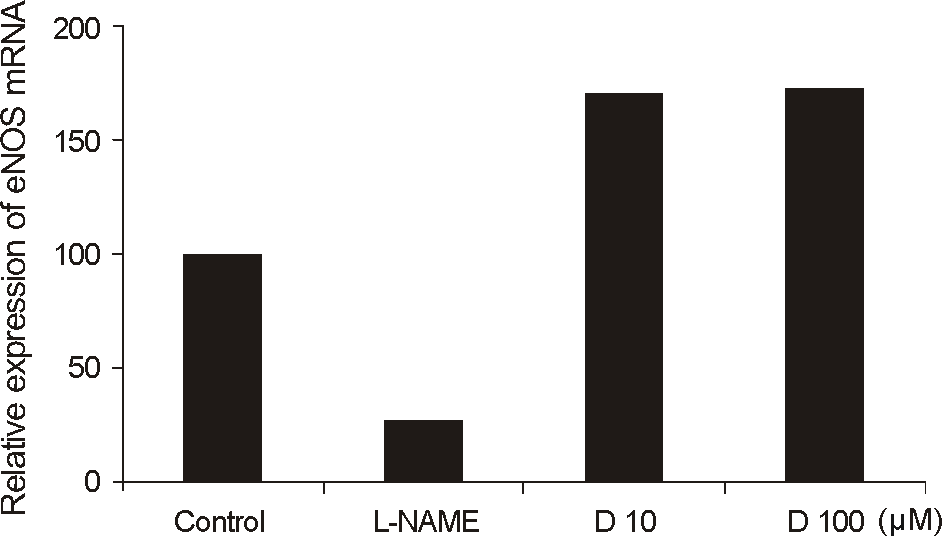
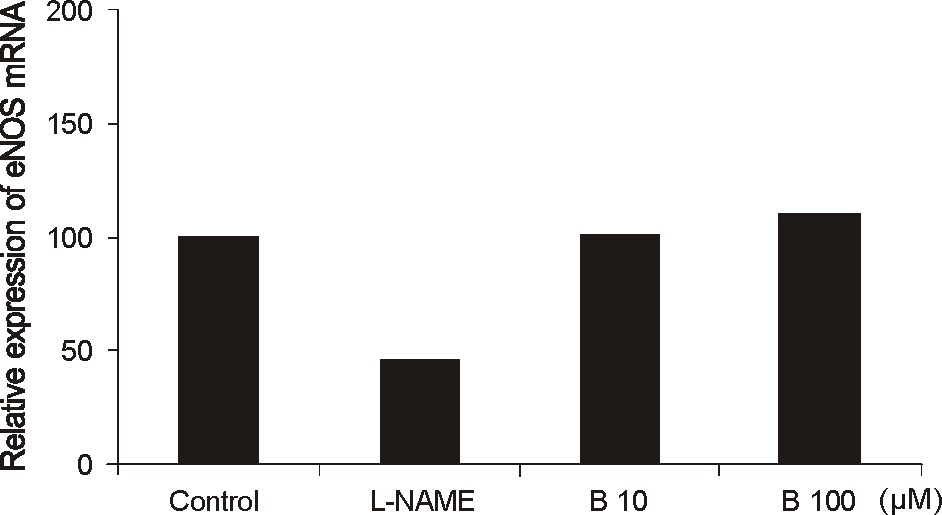
 XML Download
XML Download